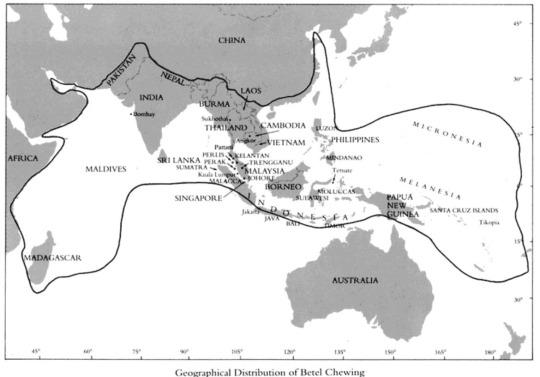#Betel Chew
Text
Just What Was Wan Smoking?
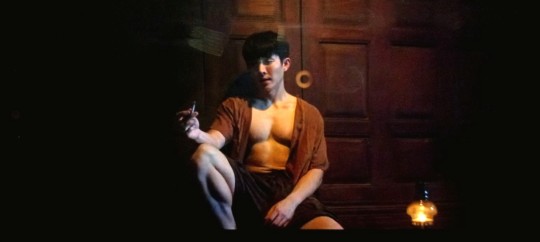
I suspect, for the most part, Wan was smoking cheroots.
Cheroots are filterless cylindrical cigars, easy to hand roll and clipped at both ends.
In Thailand, they were traditionally rolled in banana leaves and as well as tobacco, the leaves of the Indian cork tree were often added, along with the flowers sometimes for fragrance.
Things like molasses, honey, rice wine, pineapple and banana were often used to sweeten the mixture.

Sometimes cannabis could be added, which was historically used for pain relief in Thailand.
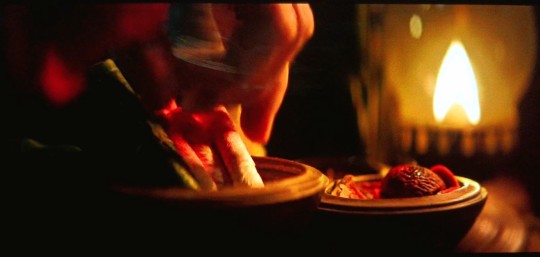
It seems like Wan relies on smoking these as a way to manage his mental health issues, like many smokers, who reach for a cigarette when they are stressed, we often see him smoking when he is feeling disturbed.
We can see from the film that Khem seems very comfortable with the act of stealing but we only ever see him steal or think about stealing, cheroots on Wan's behalf.
He even splashes out on expensive imported "cigarettes," as a gift for Wan which his friend is clearly touched by. That recognition from Khem, that these are important for Wan.
It's as if he recognises that they are something Wan needs, we never see Khem smoke himself although they were both clearly fans of betel chewing before they were forbidden to do so in ManSuang.
Hence their black teeth.

Betel nut is a stimulant and many people describe the act of chewing betel as giving them a bit of a high. It is certainly addictive but was also a standard part of socialising for a very long time in several parts of Southeast Asia and India.
As Khem and Wan are forbidden from chewing betel while they stay at ManSuang, it is likely that they both would have experienced some withdrawal symptoms and this probably made Wan rely on the cheroots even more.
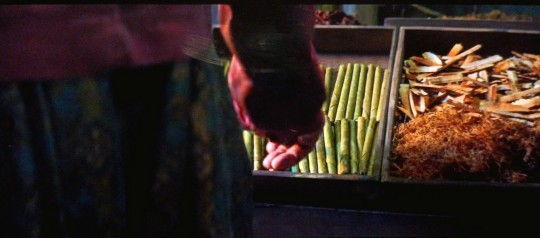
Cheroots originated in India along with beedies which historically were made from leftover scraps of tobacco and rolled into leaves.

Cheroot smoking was very traditional both in India and Myanmar.
43 notes
·
View notes
Text

Hò̂ Xuân Hương, tr. by John Balaban, from Spring Essence: The Poetry of Hò̂ Xuân Hương; "Offering Betel"
[Text ID: “If love is fated, you’ll chew it red.”]
#excerpts#writings#literature#poetry#ho xuan huong#fragments#words#selections#quotes#poetry collection#lit#poetry in translation#typography#vietnamese literature#vietnamese poetry#love#red#hunger#fate
1K notes
·
View notes
Text
According to Fransisco Alcina, who spent three decades of his religious mission in the Visayas, the Bisaya offered buyo [betel] as “the first courtesy” to guests, especially to those with high rank.
(…) Under normal circumstances, it was the women of the household who were tasked to offer buyo as a gesture of hospitality. The main matriarch handed them out when high-ranking personalities came to visit. Guests of no remark received them from female slaves. Already we see an implicit message of acceptance embedded in the act of giving buyo, and this is perhaps what makes it a clear and viable signal for sexual consent: the presence of those who receive buyo is welcomed, and by extension, those who seek sex is invited to do so when it is offered to them. Moreover, the buyo has a cosmetic component that caters to Bisaya visual preferences. Though having darkened teeth, gums, and lips may not look that alluring nowadays, and will most likely lead to an appointment with a dentist rather than being invited on a romantic night out, for the ancient Bisaya and their nearby Southeast Asian cousins these were the hallmarks of charm and allure. In his 1923 classic Malay Poisons and Charm Cures, British physician John Desmond Gimlette reports that in British Malaya the resultant “hue being communicated” after chewing buyo “is esteemed ornamental”, and that the areca, betel, and lime are the “mode of conveying philtres, or love charms.” One possible explanation emerges from this realisation: women give buyo to ensure that their partners remain or become attractive during sex. This notion is somewhat reinforced by the fact that chewing buyo slightly alleviated bad breath ("corrige el aliento").
But more than just a key to satisfy the pleasures of the flesh, buyo was also used in keeping both body and mind fit and healthy. It was an important item in local materia medica, used to treat certain diseases and discomforts of the inner constitution. For example, according to Alcina, topical application with mild pressure of the buyo leaf on the forehead relieved migraines. Boiled bonga seeds calmed agitated bowels. As can be seen, it is clear that the act of giving buyo carried with it a constellation of meanings premised under the ethos of accommodation not limited to household hospitality or sex, but it encompassed healing as well. Unwelcome guests receive none of it during their visit. Sexual prospects deemed insufficient or unattractive are refused from receiving it. Yet, in both cases, they can still be offered buyo if they are enduring certain ills, regardless of their initial intentions.
Excerpt from “The Uses of Buyo and Bonga in Ancient Visayas” (2022) by Pippo Carmona
8 notes
·
View notes
Note
is there a meaning behind your username? it's unique!
yess it does!! so in south asia (and i think southeast asia too if im not remembering wrong) we have these treats (truly not sure what to categorize them into because saying they're treats sounds off, but if im putting it into context we usually have them after meals, usually after dinner but ive seen people eat them after other meals too) that are basically betel leaves wrapped with an assortment of ingredients; the fillings depend on the person having it really and they vary from coconut to betel nut to gulkand and sometimes even tobacco.
anyways getting to the real point - paandans are containers (very beautiful you should google their pictures the work done on them is so intricate) usually coated with silver, with little compartments inside of them (they're either built in or have tiny boxes arranged inside) and you just put inside the fillings which you like in each compartment, along with the betel leaves and carry it with you. i used this as my username because of two stories -- my mom's grandfather used to have one when my mom was a kid and he used to love chewing on paan throughout the day; i also had a friend tell me about her aunt who carried around her paandan and she used to be fascinated looking at her aunt preparing the paan with such agility and precision -- both these stories put such a lovely image in head that i had to keep this as my username
7 notes
·
View notes
Text
how do you explain to non Bengalis we make a potion made out of leaf, calcium hydroxide and betel nuts and chew for fun? oh and you can add more stuff for ✨narcotic✨ side effects
5 notes
·
View notes
Text

it makes me wanna scream that society has shamed and punished ppl for desiring pleasure (drugs, sex, etc etc) and then ppl look at the distress caused by the shame and label it "addiction" that comes with an obligatory "you must recover from this to be healthy/ attain purity"

newflash, most societies do this!! I worked on a farm in Italy and everybody was sipping grappa throughout the day every day. Some ppl use betel nuts, marijuana, coffee, or tobacco, etc.
in minute 35:34 you can see this Quechua guy chewing coca leaves before starting a monotonous task.
youtube
is the whole world addicted? or are anti-drug americans just pathologizing human behaviour?
5 notes
·
View notes
Text
If I ever end up in South Asia, you know my dumb ass is gonna chew betel nut the whole time
30 notes
·
View notes
Text


sharing paan with a beloved.
their words have been dipped in a decoction of sweet jaggery and wrapped in the warm leaves of betel to be hand fed to one’s lover. verses of poetry drips from their mouths in your praises.
when they chew on the fragrant cardamom seeds laced with the reminder of the taste of your skin, your heart is also pestled with a longing.
soon the crimson stain appears on their tongue, painting a picture of the passion that they harbour for your caresses.
soon the lamps will burn out and their wicks will darken like the blanket of the night where the two lovers will unite.
#desi tumblr#desiblr#desi tag#desi aesthetic#poetry#poets corner#desi poetry#shayari#indian dark academia#old bollywood#writers and poets#young poets#poems on tumblr#indianpoet#indian movies#indian tumblr#desi culture#desi academia#being desi#desidarkacademia#desi writers#desi stuff#desi dark academia#shayarana#love poetry#mughal#painting#indian art#indian painting#mughal painting
14 notes
·
View notes
Text
The addictive betel nut is driving record rates of cancer – yet millions continue to chew it
2 notes
·
View notes
Text
Black Teeth
In the trailer for Man Suang we can see both Khem and Wan sporting black teeth.
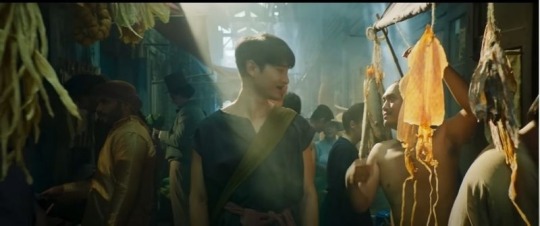

In Thailand teeth blackening was a custom of dying teeth black as a symbol of beauty. The paste used to dye the teeth was called misi and may have offered some natural protection for the teeth as well.
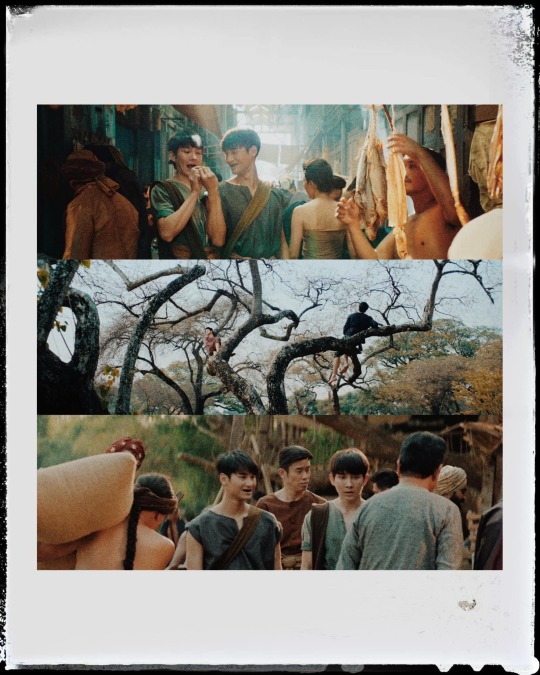
There was another cause of teeth staining which was very popular at that time and that was caused by chewing betel nuts, known as maak in Thai, which were wrapped in betel leaves and usually had lime or something else added for flavour. Betel nuts act as a mild stimulant but they stain the teeth and gums red and are associated with a number of health risks. They also have hallucinogenic properties.
Thailand went to great efforts to ban the chewing of betel nuts, including chopping down betel trees and it is rarely seen these days. For this reason, I very much doubt they are chewing betel in the film despite how popular it was at the time.
Edit: now I've seen the film I know it was betel nut they were apparently chewing, which makes sense for the time period.
26 notes
·
View notes
Text
Jar Folklore - Magsawi

Anyone else here guilty of jar hording? You finish a jar of pickles or jam and you're just like 'That's a nice Jar. I'ma keep that jar.' This seems to be a universal thing across witches and people just looking to reduce waste. Fun Fact, it's actually really hard to recycle glass. Not for the same reason as plastic; it's all the same material that can be melted down again and again. The problem is the colour. Clear jars are always made with new material because recycling can't realistically pick out the coloured bits. So reuse your clear jars!
One part that can be frustrating is the labels. Some peel off real easy once wet, others you swear were stuck on with rubber cement >.<
You don't need a lot of stuff to get labels off of a jar. Just a decent amount of time.
Rinse out your empty glass jars. Begin to fill your clean kitchen sink with hot water from your tap. Apply and saturate your jar's labels with liquid dish soap. You can also add a little soap into your hot water if you want. Place your jar in the sink on it's side and continue to fill with hot water until covered. Leave your jars to soak for several hours; maybe overnight.
Once soak has completed, take jar and begin to pull label away. Label should come off easily with minimal force. Use your thumb nail or back of a wooden spoon to help with scraping. Scrub remaining bits off with wash cloth or sponge if needed.
Once label is completely gone, give your jar a proper wash. I stick mine in the dishwasher. Now it's ready for use.
Tips: Don't put the jar in the dishwasher before the label is off. It will just seal it on harder, like stuck on food.
-If the label is being stubborn, redo the soak. Or try letting it sit with a baking soda paste for a bit.
-Do not give into temptation and try using something abrasive to scrub the label off. Steel wool and SOS pads can scratch glass.
I found a Filipino Folktale about Jars. Or rather beings in jars. It brought back memories of the days of making fairy jars or spirit jars. But it's always a good reminder about how Jars can contain great power. Even if others don't always understand it.
A great many years ago some Tinguian left their little village in the valley early one morning and made their way toward the mountains. They were off on a deer hunt, and each carried his spear and head-ax, while one held in leash a string of lean dogs eager for the chase.
Part way up the mountainside the dogs were freed, and the men separated, going different ways in search of game. But ere long the sharp barking of a dog called all in his direction, for they believed that he had a deer at bay. As they approached the spot, however, the object did not look like a deer, and as they drew nearer they were surprised to find that it was a large jar.
Filled with curiosity they pressed on, but the jar evaded them. Faster and faster they ran, but the object, disappearing at times and then coming into view again, always escaped them. On and on they went until at last, tired out, they sat down on a wooded hill to rest and to refresh themselves with betel-nut which they took from brass boxes attached to their belts.
As they slowly cut the nuts and wrapped them in the lime and leaf ready for chewing, they talked of nothing but the wonderful jar and the mysterious power it possessed. Then just as they were about to put the tempting morsels into their mouths they stopped, startled by a strange soft voice which seemed to be near them. They turned and listened, but could see no person.
“Find a pig which has no young,” said the voice, “and take its blood, for then you will be able to catch the jar which your dog pursued.”
The men knew then that the mysterious jar belonged to a spirit, so they hastened to do as the voice commanded, and when they had secured the blood the dog again brought the jar to bay. The hunters tried to seize it, but it entered a hole in the ground and disappeared. They followed, and found themselves in a dark cave where it was easy to catch the jar, for there was no outlet save by the hole through which they had entered.
Though that was many years ago, the jar still lives, and its name is Magsawi. Even now it talks; but some years ago a crack appeared in its side, and since then its language has not been understood by the Tinguian.
Sometimes Magsawi goes on long journeys alone when he visits his wife, a jar in Ilocos Norte, or his child, a small jar in San Quintin; but he always returns to Domayco on the hillside near the cave.
#Glass Jar#Jars#Jar Witchcraft#food and folklore#kitchen witchcraft#fairytale#folktale#folklore#Fable#filipino#October#Jar Magic#Magic#Witchcraft#save your jars#klickwitch
2 notes
·
View notes
Text
i love reunion so far but apparently its think critically about your fave media tuesday so!! a while ago i got super excited about the village arc in reunion being filmed in myanmar (because hey - that's my country, and you never see it anywhere!) but then was super disappointed and not surprised with how it was actually portrayed. yes, the "we're in, uhhhhhhh, Unspecified Southeast Asian Village" is pretty fucking funny considering i can see the burmese language posters in the back, and yes hei xiazi running weirdly in a htamein gives me a good laugh (huge mood), but beyond that, reunion falls back on old tropes about myanmar and also tropes which i think apply to a lot of SEA countries in general.
these include a general viewing of burmese (read: lots of SEA countries too) culture as primitive and savage while simultaneously exoticising it for, i don't know, the mysticism factor. persecution of ethnic minorities is already a big big problem in myanmar and this portrayal of what I am assuming is an ethnic minority group (although it doesnt look like any of the actual ethnic minorities we have in myanmar to me) really is not doing any favours -_-.
again, reunion is far from the only piece of media to portray us in this way (see also: anna and the king, from what i can remember) but the issue is that myanmar just does not show up in internationally distributed media at ALL and in the rare, rare, rare occasion it does, it's to be shown like this. when we're not uhhhh (checks notes) uncivilised villagers running arcane rituals and mutilating children, we're (checks more notes) violent thugs under the thumb of a corrupt military?
and yes, unfortunately the military thing DOES sort of apply, especially right now (rest in power Ko Jimmy, Phyo Zayar Thaw, Hla Myo Aung, and Aung Thura Zaw), and it deserves to be drawn attention to - but it's not the only thing!! there are other things!! we are so many of us with our own many cultural practices and cool shit that deserves to be appreciated and not exoticised
also, the little girl from the village - please stop chewing betel leaf!! your teeth are going to be so stained!! you can chew betel leaf when you're older 😭
this is really just a very muddy collection of thoughts and i don't know where i'm going with it other than i'd like to write a thing of the tltr cast just having fun in my hometown. visiting a street food stall! going to a pagoda! getting fucking Obliterated by the loudspeakers on the donations truck that comes around every evening (personal experience)!! etc etc there is so much more to my country and others in SEA than this
(just in case: SEA here is an abbreviation for South East Asia)
#please note this isn't a Thoughtfully Written Critical Post or whatever#it's very messy and is essentially stream of consciousness#brought to you by a burmese guy who's tired of this shit!#and ofc obligatory disclaimer#this is just one of a couple problems reunion has#and i still like it!#it fucks!#you can like things and criticise them are we agreed on this yes yes thank you#now that that's out of the way. who in reunion would whine the most about our showers#trick question. hei xiazi no contest#reunion: the sound of the providence#please add onto this i dont wanna be a one man echo chamber!!#dmbj
41 notes
·
View notes
Note
Hello! Your bibliomancy readings sound interesting, I would love one please! H: 57, 380, 418. Thank you 💐
Hello to you! I hope you are well! You are most welcome c:
You have a bouquet from my Language of Herbs book! As yours are all in different letter sections (A, P, and R), I will create your bouquet for you!
In your bouquet, you have: Aquilaria Malaccensis (Agar-Agar), Piper Betle (Betel Leaf), and Rosa Gallica (Gallic Rose).
Together their meanings comprise of life, loyalty, and variety.
For you when I look at your bouquet, I see how the elements blend together to create a distinct smell and visual presentation. With the presence of Aquilaria Malaccensis, most often used for incense and perfumes, it acts as a binding power between Piper Betle and Rosa Gallica. There is a distinctness to the Piper Betle in your bouquet as it presents itself as a strong, protective force. The leaves of that plant are most often used as a flavor for Betle nut chewing (which can be a spicy and sweet flavor). Combined with Rosa Gallica, this adds a certain element of softness and affirmation to you. I will make a small note that there does feel like this comes from an outside presence and this is a reminder to you. The smell of the two together is spicy, sweet, and floral.
Overall, when I look at it all. It is a reminder to you about a bond you have with someone else. With the binding force of the Aquilaria Malaccensis between Piper Betle and Rosa Gallica, it is a message to you that you are protected, and a reminder you can be strong and gentle simultaneously. There does not appear to be any other message other than this affirmation to you.
1 note
·
View note
Text
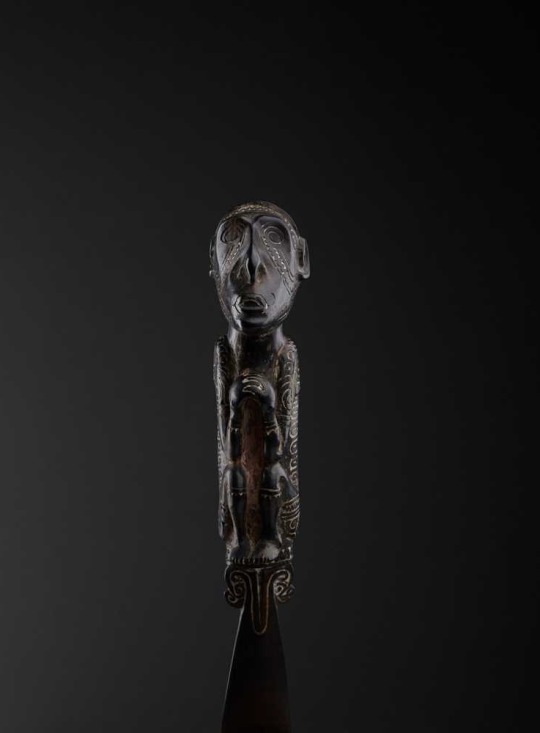

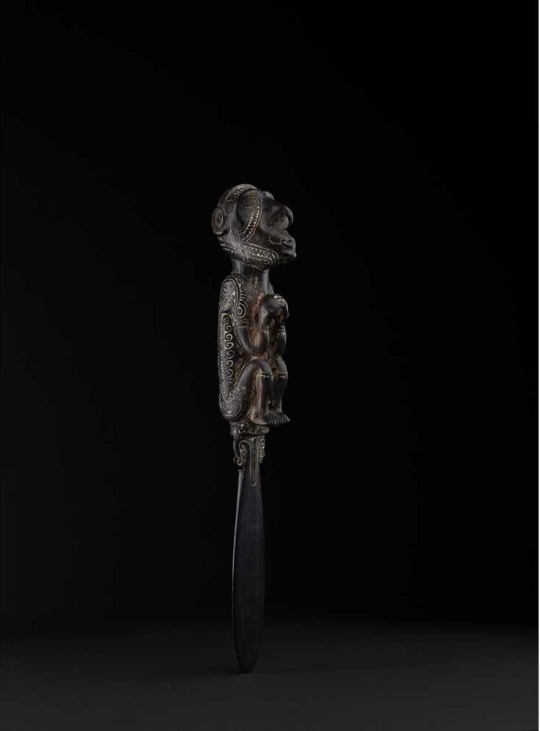

LIME SPATULA BY MUTUAGA
PAPUA NEW GUINEA, C. 1900 - 1910
carved wood, seated upon a circular platform above the blade, the handle in the form of a graceful squatting figure, shown with the hands clasped together, knees bent and drawn up into the body, the large head gazing upwards, with prominent nose, ears carved in high relief and carved bands scrolling into the eyes, the body and skull decorated with intricate incised motifs filled with lime, fine glossy patina.
The names of the vast majority of traditional Oceanic artists are lost to time. One noted exception is the master carver Mutuaga (fl. 1860’s - c. 1920), who achieved great renown in his own lifetime for the quality and poignancy of his work. Born in southeastern New Guinea c. 1860, Mutuaga worked in the Massim tradition of producing spatulas for the chewing of betel nut, a mild stimulant.
His work was quickly noticed and promoted widely, ultimately finding its way into galleries and museums across the world, even into the collections of artists such as Jacob Epstein.
The present piece is a rare example of his work, indeed less than thirty-five spatulas have been attributed to him. It aligns most closely with Beran’s (1996, p. 137) Style Variation 3 and dates to c. 1900 - 1910, a period in which Mutuaga’s work was becoming increasingly naturalistic.
Lyon and Turnbull
4 notes
·
View notes
Photo
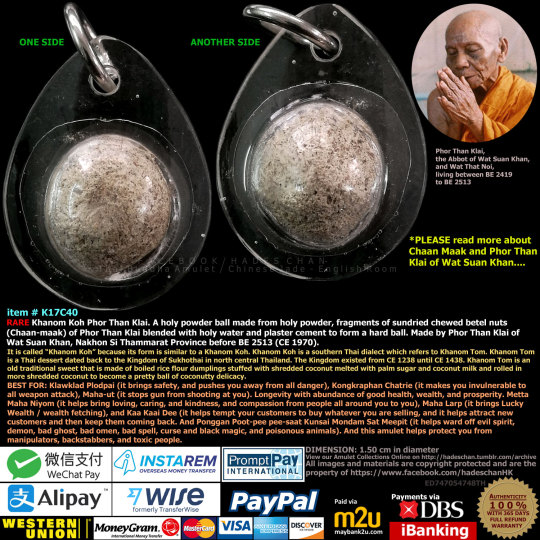
We’re sorry, this item has sold out
item # K17C40
RARE Khanom Koh Phor Than Klai. A holy powder ball made from holy powder, fragments of sundried chewed betel nuts (Chaan-maak) of Phor Than Klai blended with holy water and plaster cement to form a hard ball. Made by Phor Than Klai of Wat Suan Khan, Nakhon Si Thammarat Province before BE 2513 (CE 1970).
It is called “Khanom Koh” because its form is similar to a Khanom Koh. Khanom Koh is a southern Thai dialect which refers to Khanom Tom. Khanom Tom is a Thai dessert dated back to the Kingdom of Sukhothai in north central Thailand. The Kingdom existed from CE 1238 until CE 1438. Khanom Tom is an old traditional sweet that is made of boiled rice flour dumplings stuffed with shredded coconut melted with palm sugar and coconut milk and rolled in more shredded coconut to become a pretty ball of coconutty delicacy.
………………………………………………………..
Chaan-maak
Chaan-maak is a left-over paste of betel nuts, betel leaf and lime after chewing by monks. Chaan-maak is considered as an auspicious and powerful object because most of Guru Monks are chewing betel nuts in their mouths while praying, chanting and blessing.
………………………………………………………..
BEST FOR: Klawklad Plodpai (it brings safety, and pushes you away from all danger), Kongkraphan Chatrie (it makes you invulnerable to all weapon attack), Maha-ut (it stops gun from shooting at you). Longevity with abundance of good health, wealth, and prosperity. Metta Maha Niyom (it helps bring loving, caring, and kindness, and compassion from people all around you to you), Maha Larp (it brings Lucky Wealth / wealth fetching), and Kaa Kaai Dee (it helps tempt your customers to buy whatever you are selling, and it helps attract new customers and then keep them coming back. And Ponggan Poot-pee pee-saat Kunsai Mondam Sat Meepit (it helps ward off evil spirit, demon, bad ghost, bad omen, bad spell, curse and black magic, and poisonous animals). And this amulet helps protect you from manipulators, backstabbers, and toxic people.
………………………………………………………..
Phor Than Klai of Wat Suan Khan
Phor Than Klai Vajasit, the “Vajasit” means “whatever he says surely comes true”. Phor Than Klai is one of Holy Guru Monks of the South of Thailand. Phor Than Klai was an abbot of Wat Suan Khan, and Wat That Noi, Nakhon Si Thammarat Province.
Phor Than Klai, born Klai Sinin in BE 2419 (CE 1876) and passed away in BE 2513 (CE 1970) at the age of 94 years old and his body is still intact and displayed in a glass casket at Wat That Noi (Wat Chan Di), Nakhon Si Thammarat Province.
Phor Than Klai was one of the holy guru monks worshipped by the King Bhumibol Adulyadej of Thailand. And amulets made or blessed by Phor Than Klai have performed countless of magical power of Klawklad Plodpai (it brings safety, and pushes you away from all danger), Kongkraphan Chatrie (it makes you invulnerable to all weapon attack), Maha-ut (it stops gun from shooting at you). The press and social media are continuously writing about the miracle of Phor Than Klai’s amulets til these modern days. And the holy water blessed by Phor Than Klai is believed to have healing power that could cure any illness, and bring good health and longevity.
NOTE: Phor Than is a southern Thai dialect refers to Luang Phor (Father) in central Thai dialect.
………………………………………………………..
DIMENSION: 1.50 cm in diameter
………………………………………………………..
item # K17C40
Price: price upon request, pls PM and/or email us [email protected]
100% GENUINE WITH 365 DAYS FULL REFUND WARRANTY
Item location: Hong Kong, SAR
Ships to: Worldwide
Delivery: Estimated 7 days handling time after receipt of cleared payment. Please allow additional time if international delivery is subject to customs processing.
Shipping: FREE Thailandpost International registered mail. International items may be subject to customs processing and additional charges.
Payments: PayPal / Western Union / MoneyGram /maybank2u.com / DBS iBanking / Wechat Pay / Alipay / INSTAREM / PromptPay International
**********************************************
1 note
·
View note
